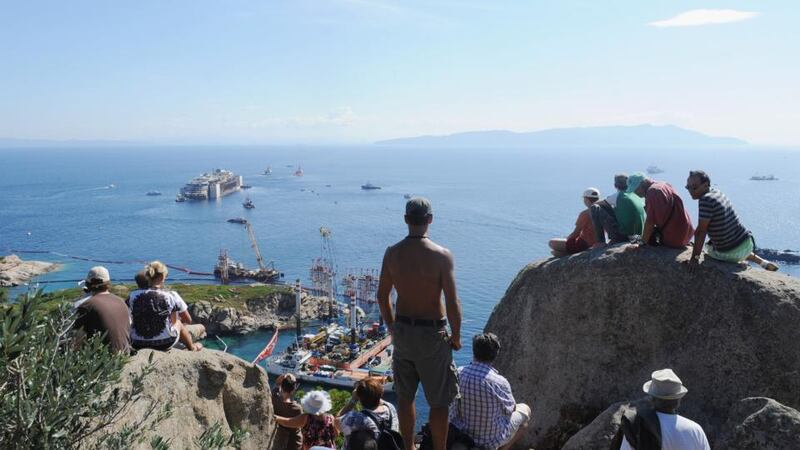From a distance, she looks like a huge patched-up travel trunk that someone has dumped in the sea.
Up close, it is difficult to be sure that she is actually moving. Yet, the reality is that one of the most ambitious maritime salvage operations of all time appears to be moving inexorably to a safe conclusion as the stricken luxury liner, the Costa Concordia, makes her way north to Genoa and dismantlement.
At ten o'clock this morning as the last cables were released, the fog horns sounded and one of the tugs threw up an impressive arc of spray as the Concordia finally left the island of Giglio, destination Genoa.

Trust up like an oven-ready turkey, with a set of giant biscuit boxes welded onto both her sides to hold her together, the Concordia and her armada of support boats will take five days to travel to Genoa, sailing along at the ultra-slow pace of 2.5 knots per hour and due to pull into the port of Genoa sometime on Sunday afternoon.
Out at sea, the “armada” is working out exactly as it has been described all week long to the media, a point that the salvage team underlined by taking some of us out to sea to watch the ship close up in the water.
In other words, the Concordia is being towed sedately along by two powerful tugs, just 700-800 metres in front of the liner, while the support boats keep their distance, behind the liner and off to either side.
These boats are there to pick up any debris or liquids that may be released by the Concordia on the trip.
On top of that, the armada is being closely observed by a coast guard ATR 42 plane, which will use sophisticated heat related equipment to monitor changes in the sea’s temperature, caused by any unwelcome pollutant.
Furthermore, another boat in the fleet will monitor the voyage route with a view to marine wildlife, in particular shoals of dolphins, advising salvage master Nick Sloane accordingly.
Remarkably, the removal of the Concordia has thus far gone much more smoothly than anyone might have dared to hope.
Mr Sloane had suggested yesterday it might be mid-afternoon before the ship had moved off from the island.
Yet, within a quarter of an hour of the suspension of harbour traffic at 8.30 yesterday morning, the ship had already moved from the shoreline and was clearly on its way.
Inevitably, the departure was greeted with huge enthusiasm on the portside. In the Bar Monti, they were playing “We Are The Champions” while out on the harbour front reporters who attempted to interview the salvage team workers found themselve drenched in celebratory champagne.
At a news conference this morning, Franco Gabrielli, head of the Civil Protection service, was the man to give the historic confirmation that the accursed ship was finally on its way.
In contrast to the salvage workers, Prefect Gabrielli said that he had an obligation to remain “sober” and, above all, to recall the “reason why we are all here”, namely a shipping tragedy in which 32 people lost their lives.
That press conference was too marked by a sense of great satisfaction with Costa Cruise salvage engineer Franco Porcellacchia confirming that thus far the Concordia was responding much better than anyone had anticipated.
The Mayor of Giglio Sergio Ortelli probably spoke for all his fellow islanders when he said that “this is the most important news conference ever held on Giglio”, going on to express the islanders’ gratitude to all the salvage team for their work in an “operation that we will never forget”.
He also expressed his thanks to his fellow islanders for the generous manner in which they had reacted not only to the original tragedy in January 2012 but also for the manner in which they had absorbed and collaborated with the impact of the entire 30 month long rescue com salvage operation.
Speaking on behalf of the Italian government, Cabinet Under-Secretary Graziano Del Rio also recalled those who had lost their lives in the shipwreck, saying:
"The Concordia has gone but it has not taken away the suffering of the families of the victims and today's success is a tribute to all those victims...This is our country, Italy, a country can learn from and react to its mistakes...in this case, the error of a single person (Captain Francesco Schettino)...This was an incredible, unique operation that can give us hope for the future...
“We want to thank all those who have transformed an unforgettable tragedy into a situation in which intelligence, solidarity and competence have managed to erase the image of a country that cannot learn from its errors...
The Costa Concordia, of course, ran aground off nature reserve Giglio in January 2012 with the loss of 32 lives.
The shipwreck had been prompted by an ill-advised “sail-by” close to the rocks of the island, a sail-by ordered by Captain Francesco Schettino and a sail-by which came to a disasterous end when the ship hit the rocks, opening up a 70 metre gash below water.
Capt. Schettino is currently being tried for multiple manslaughter, causing a shipwreck and abandoning his ship.
A judgement in his trial is expected some time next year.








